It’s time to start growing your audience, but what do you share? Teaching everything you know is a common path, but what if you’re not ready to teach?
I’d like to suggest you start by curating.
When you focus on curating content from other creators you are able to start building an audience without the burden of creating everything yourself. Then you have full control and can slowly work in your own content as you become more comfortable creating it.
I started by curating
Back in 2010 when I started to learn iOS development I searched everywhere for resources and articles. In that process I came across Dave Verwer’s iOS Dev Weekly. Each week Dave would send 5-7 links to articles to help you learn Objective-C and iOS development.
While I enjoyed it, I thought it could use a few design resources mixed in as well to help developers understand design. So I’d send him links to articles I found helpful.
iOS Design Weekly
Eventually I realized I had found so many resources to share that it didn’t make sense to keep trying to get Dave to feature them each week. So I asked if he’d mind if I started my own that was design focused and he thought that was a great idea. He even included a link in one of his newsletters a few weeks later.
Within a week I had registered a domain, started a newsletter, and designed a landing page. During launch week I received 258 subscribers from a mix of Dave’s mention, Twitter, Hacker News, and Reddit. You can read more of the story here.
Adding my own content
During the next year I gradually started to become comfortable writing my own original content. I kept curating, but would add a link to one of my own tutorials after publishing. This added a personal note and gave the subscribers a bit of a connection to me.
Then when I started working on my blog more seriously, I started another email list for that newsletter. I grew both in parallel until after I launched The App Design Handbook (my first book). By that time I had nearly 800 people on my newsletter and a few more on the iOS design weekly list. The two audiences had about 40% overlap. So I’d send dedicated emails about the book to my list, and then include a mention in iOS Design Weekly.
This was a great way to kickstart my own audience, get comfortable sending on a consistent schedule, and learn the basics of email marketing.
Eventually when my own newsletter was larger than the iOS Design Weekly list I shut down the curated list and let them all know to follow me on my blog newsletter.
Learn from the best
There are so many great examples of audiences built through curation and even seasoned creators who provide value each week through curation.
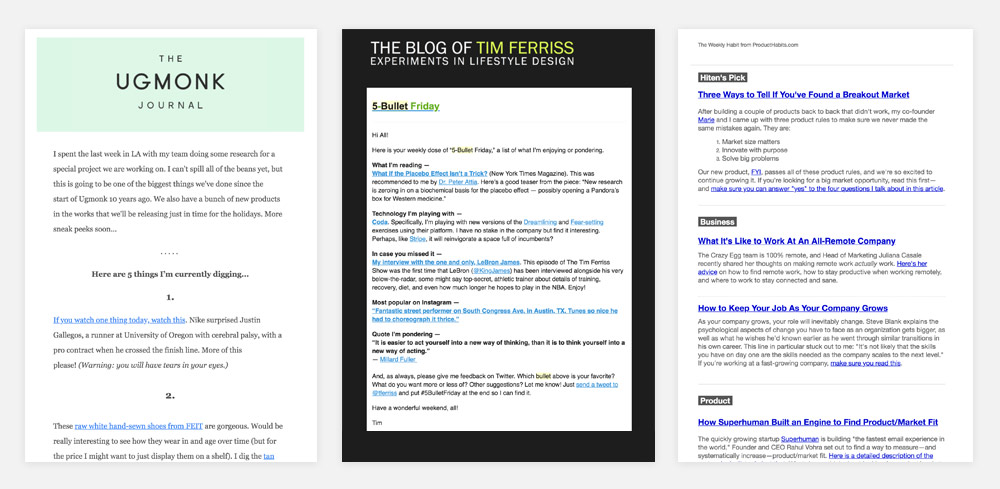
5 Bullet Friday
Tim Ferriss runs one of the largest email newsletters on the internet (it’s powered by ConvertKit!) and he built it through curation. Each Friday he sends out an email with his favorite quotes, content, and purchases. Sometimes he includes his own content, but it’s most often a curated list.
Ugmonk
Jeff Sheldon runs a great ecommerce brand called Ugmonk. His email list is quite valuable when it’s time to run a sale or launch a new product, but what should he send in the mean time? He’s focused on developing new products, not writing articles or filming videos.
So he sends out a monthly curated list of his favorite things called “5 things I’m digging — November Edition”
While it’s mostly focused on links you might enjoy, it often starts and ends by talking about Ugmonk products.
Product Habits
Hiten Shah runs a weekly newsletter called Product Habits. Each week it has articles on business, product, design, and marketing. Then he will also send his own content (or any action he wants you to take) in a separate email that week.
Art of Visuals
Prince McClinton built a massive Instagram community called Art of Visuals entirely through curation. He featured the best photographs he could find and directed fans to follow their work.
Eventually the community grew with thousands of photographers submitting their own photos to be featured. Now over 1.4 million people follow Art of Visuals and it’s grown into a full brand with a website, products, an email list, and significant revenue!
Cooper Press
Peter Cooper has grown developer newsletters into a substantial business. What started with JavaScript Weekly has grown to a collection of newsletter with a combined readership of 415,000 subscribers.
My holiday gift guide
Even the gift guide I wrote a couple weeks ago is a form of curation. I don’t normally write about what gifts to buy, but curating a list of my favorites made for a popular blog post.
Earning a living from a curated audience
Once you capture attention you can turn it into a living a few different ways:
- Sponsored content
- Affiliate marketing
- Promoting your own products
Sponsored content
iOS Dev Weekly is a great example of sponsored content. Along with the the organic links in each newsletter there is also a sponsored link. It is always to something useful and relevant to the audience, but a company pays to be included. In that newsletter with 45,000 readers the sponsored link costs $1,500. $6,000 a month as baseline revenue isn’t bad!
Affiliate marketing
Affiliate marketing is similar in that you are paid for sending traffic to a product that isn’t yours, but you are paid a commission for each sale, rather than a fixed amount up front for the ad placement.
Promoting your own products
Often a curated list promoting their own product is clear (like with Ugmonk), but other brands are less direct. The instagram account Artisan Born curates beautiful custom woodworking from all around the world.
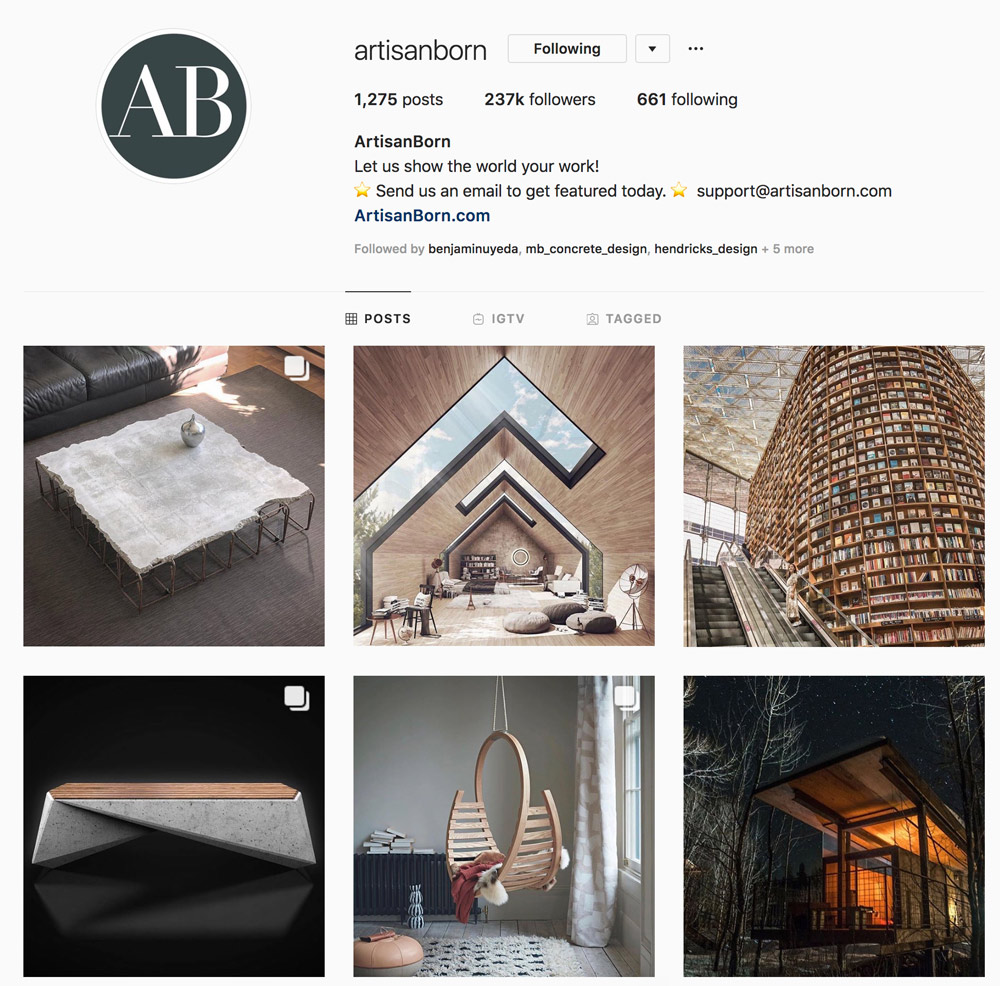
I followed them for a few weeks before I clicked through to understand what they were selling: wood slabs for woodworkers to build live-edge tables and other unique projects.
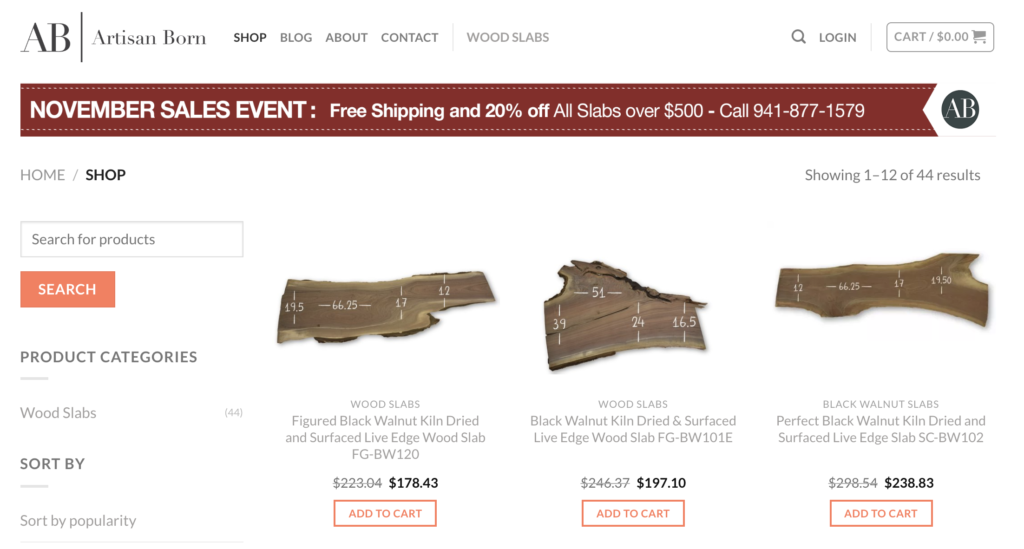
By curating the best work of their target customer they were able to build an audience of nearly a quarter million followers. Now when they want to promote a sale in their stories or in another post they have a large community.
Curate your own audience
If you’re intrigued by the idea of using curation to grow your own audience, let’s dive in!
Make a system
The first step is to make a system you can work, rather than simply posting sporadically or without focus.
- Choose a narrow topic — Focus your topic on a specific niche and you’ll have an easier time attracting followers. That means started “iOS design weekly”, not “design weekly.”
- Choose a cadence — Next choose the cadence you’ll share on. The most common will be weekly or monthly. Commit to something you know you can maintain consistently.
- Systematize idea collection — Decide exactly how you are going to log ideas. This could be a whiteboard in your office with each empty slot ready for you to write something down, a Google Doc to drop links, and a place for readers to submit their own links. Just design a system to make it simple.
- Automate your reminders — The final step is to put reminders on your calendar and anywhere else that will keep you consistent. I like to use the streaks app
Pro tip: don’t just add a calendar reminder for “publish newsletter” on the day it is supposed to go out. Also add, “prep newsletter” or something similar a few days before so you aren’t right up to the deadline.
Let’s put what we’ve learned in practice by starting a couple pretend newsletters.
Example 1: X-Carve Weekly
Inventables makes a product I absolutely love called the X-Carve. It’s a kit for building your own CNC machine. If you follow me on Instagram you’ve seen random woodworking projects brought to life through custom carving and inlay.
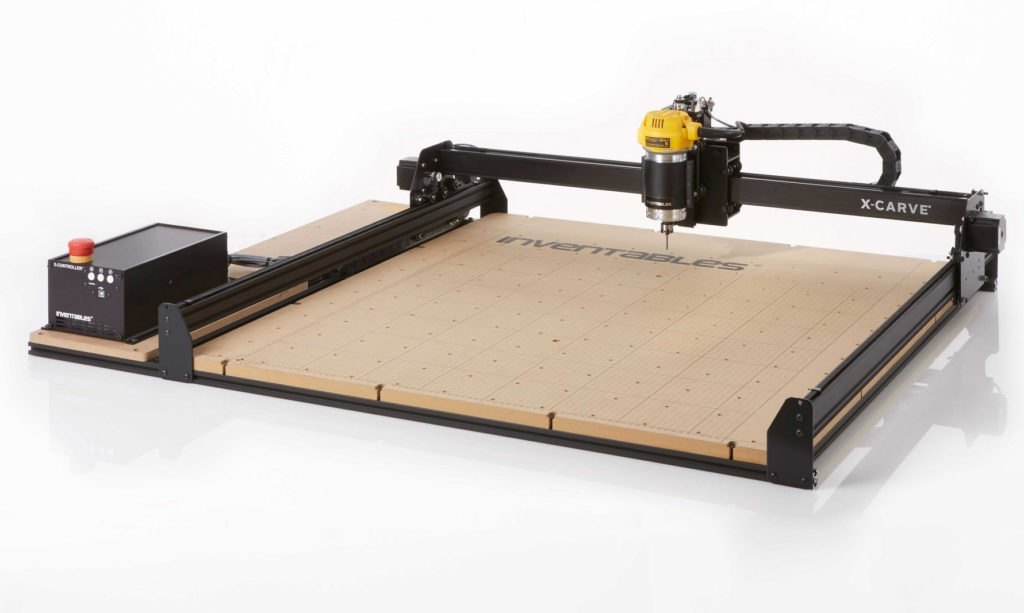
If I didn’t already have too many projects then I’d start a community around helping makers get the most out of their new toy tool.
Since I’m not going to do that, let’s just pretend to create X-Carve Weekly, a weekly email with the best X-Carve tips, tutorials, and inspiration.
Note that instead of starting “Woodworking Weekly” or something more broad, we focused in specifically on users of an exact tool. This will make it easier to understand our target market and attract subscribers.
Next I like to break down the links into categories. Instead of it growing or shrinking based on how many tutorials I can find that week, I want an exact format with four slots:
- Featured project — What’s the coolest thing you’ve seen made on the X-Carve recently? This allows us to start the newsletter with great visuals.
- Full tutorial — Either an article or a YouTube video walking through exactly how to build a project or learn a new skill.
- Free Easel project — The software used to run the X-Carve is called Easel. Inside that you can share projects that other people can import and carve themselves. This is great for beginners to import something and hit carve within a couple minutes to show them the power of the X-Carve.
- Quick tip — Then we’d close out the newsletter with a quick tip. This could be about bits, design techniques, converting graphics, or anything else.
With these categories defined, I’d then hang a small whiteboard in my office with each category on it. The board would be a constant reminder to curate more links and think about what projects I wanted to highlight.
Then once I had some more content and wanted to bring in my own personality or story, I’d add another section called “My Build” where I showcase what I made on my own X-Carve that week.
Choose your industry
This simple format could be applied to any topic you want (filmmaking, podcasting, woodworking, homesteading, etc). It’s the perfect way to blend your passion and learning with building an audience.
Example 2: e-commerce store
Now let’s say instead you already have an established process, but don’t know what to send to your email list. That’s where we can follow Ugmonk’s example and curate a monthly newsletter.

For this one we’ll use my friend Jason’s surf and paddle board company, Hydrus, as an example (since he and I talked about these ideas over coffee last month).
Here’s what I suggested for his monthly newsletter:
- Featured customer photo — Because high-end paddle and surf boards are such an active product, it’s great to showcase action shots rather than just product photos. By featuring a customer photo in each newsletter they can build the community and show their product in action around the world.
- Paddle boarding skills — With how popular paddle boarding has become many beginners don’t know proper technique aren’t getting the most out of their boards. By showcasing skills and technique each customer will find value and learn to love the sport even more.
- Behind-the-scenes — The process of custom building boards is pretty fascinating, so why not show it off? This section can be a link to an article or video of the Hydrus shop, process, or team. This is where they can showcase what makes their products different and really tell a story.
- Featured product — And finally they can cap off the newsletter by featuring a product. What’s the story behind it? Why was it designed that way? What makes it great?
By following this process Jason can take a growing email list and provide them value without too much effort. Each subscriber will gradually learn new skills, get inspired, and become more of a fan of the brand. Eventually buying more boards!
It’s time to start!
Now that we’ve practiced the curation method with two different examples it’s time to jump in and create your own!
Here are the steps:
- Choose your topic
- Sign up for a ConvertKit account
- Create a landing page (it takes 5 minutes)
- Share it on Twitter, Facebook, and text it to 5 friends
Then comes the harder part: commit to doing it week after week for a year. If you do that, I promise you won’t regret it!
Once you build the foundation, you can always pivot
Over time you can pivot into including more of your own products, personality, stories, and teaching. For example, one of the slots could always be something that you made. Then it puts your original work on par with what the experts around the web are making. Which is always a good place to be!
Grow your audience
Curating is a great way to both build your audience and improve your taste. Focusing your time on finding and sharing great products will give you a better understanding of why a product or idea is good. Improving your taste that you can apply back into what you create.
Plus, you won’t regret building an audience who will follow whatever you put out.
***
Two simple questions to close us out (feel free to answer either one):
- What would you curate a newsletter about?
- What are your favorite curated newsletters?
Let me know in the comments.
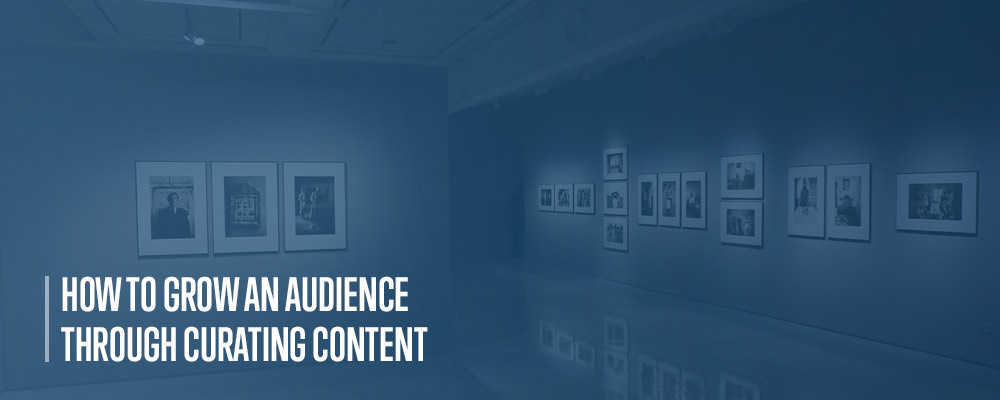

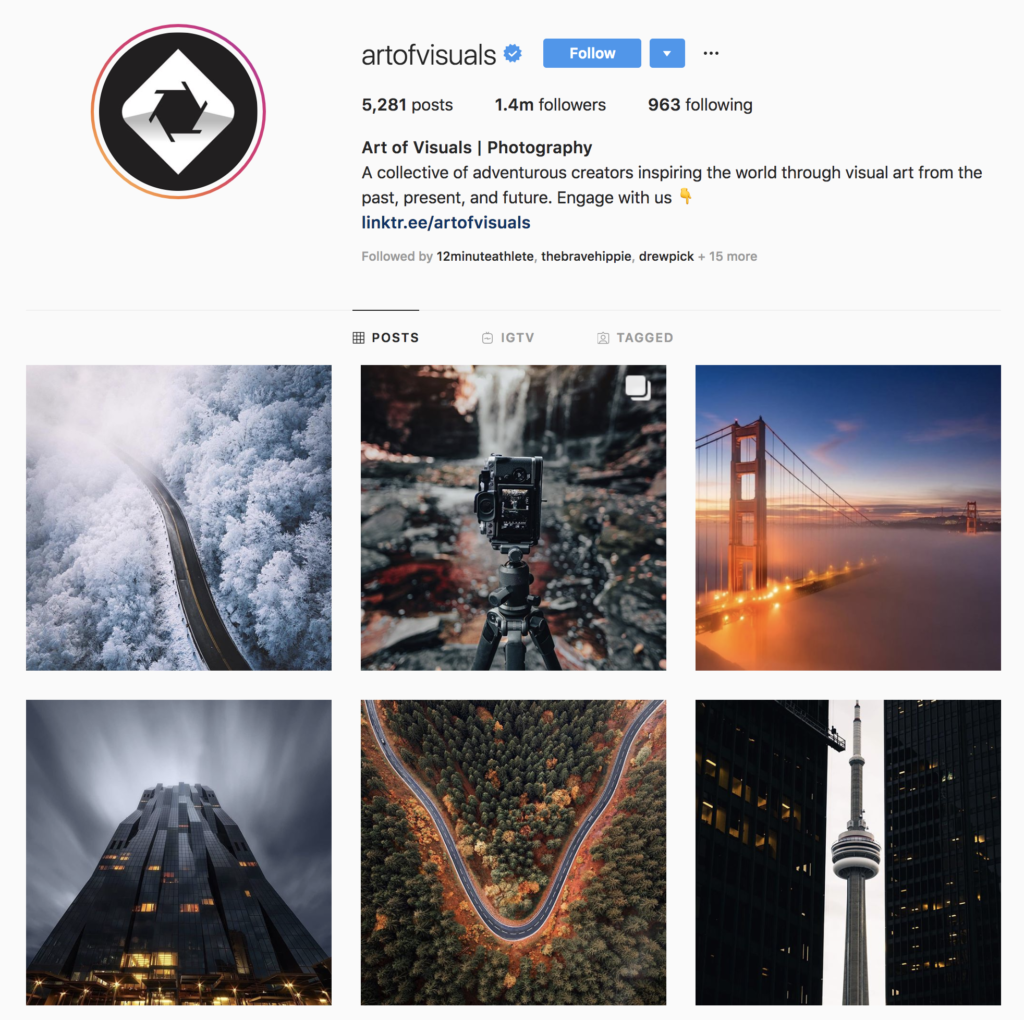
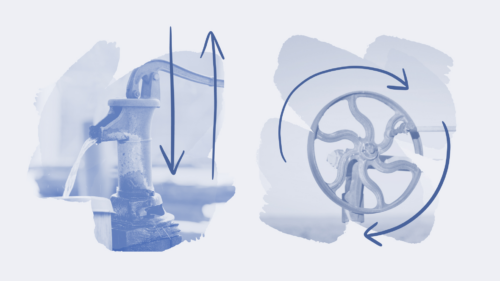
Great article, Nathan! One of my favorite new curated newsletters is Dense Discovery from Kai Brach (creator of Offscreen Magazine). He curates articles around tech, design, and culture then sends them out every Tuesday.
I also do a weekly curated newsletter at my agency, 45royale. We gather the week’s best design, development, creative business, app, and geek resources and share them with our audience. You can sign up here if anyone’s interested.
Matt, I like Dense Discovery too! I also like Rad Reads and For the Interested and many others! Just signed up for your newsletter.
Thanks for the recommendations, Joe. I just signed up for Rad Reads and looking in to “For the Interested”. And thanks for signing up to my newsletter, we’ll see you this Friday!
Great article. This is something I have considered as a business model with including sponsored and affiliate content. I am considering topics like my hobbies (fly fishing, hunting, wood crafts). Have you even seen an business built on this model alone? Thanks!
I’ve set up a few businesses using curated content and my top tip is to focus on the reader first. Applying the Craigslist-type model of having the majority of your content un-affiliated and some affiliated means it’s more unbiased and resonates with people better. One business that is earning solid revenue is https://softwareforprojects.com/ , happy to share others.
BTW Great post Nathan and a solid framework for using curation to add a tonne of value to people and increase engagement.
Nathan! Great article on curation. I curate a newsletter for nonprofits and businesses that want to build win-win partnerships (aka Cause Marketing). It’s very niche, but it’s been very successful. And, of course, I use ConvertKit!
I archive them on my blog: https://www.selfishgiving.com/blog/
I’m teaching my nonprofit clients how to use curation in their newsletters. Of course, I suggest they do it on CK!
Nathan! This is so good! I’ve been a huge fan of Tim’s Friday emails – this totally inspired me to do something like that as well! So fun! Thanks for the resources! Hope you and your family are doing well!
That’s a great post! I also like the weekly of Kirby CMS and the list from a blog post on Smashing Magazine. Never thought about creating my own! Great inspiration!
Useful post. Thanks.
I have always been fascinated by this business model. I think the biggest problem is how to get enough subscribers in the beginning.
Tim Ferriss started his newsletter when he already had lots of visitors loving him.
How do you grow when you start from 0 without publishing on a blog?
I enjoy Further by Brian Clark.
I’m fairly new at this kind of thing. If curating means using other people’s articles, wouldn’t it be necessary to get their permission before you used it?
The same with photographs – I would think permission would be necessary.
Patricia Plake
PS Loved the piece about the Ghost Town. What fun!!!